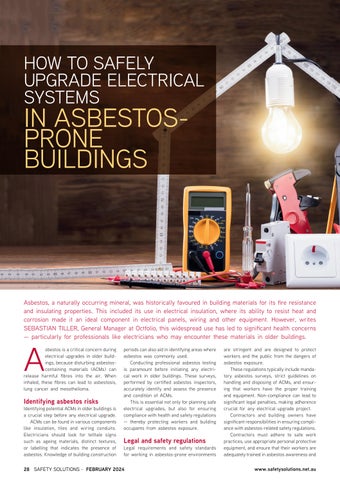HOW TO SAFELY UPGRADE ELECTRICAL SYSTEMS
IN ASBESTOSPRONE BUILDINGS
Asbestos, a naturally occurring mineral, was historically favoured in building materials for its fire resistance and insulating properties. This included its use in electrical insulation, where its ability to resist heat and corrosion made it an ideal component in electrical panels, wiring and other equipment. However, writes SEBASTIAN TILLER, General Manager at Octfolio, this widespread use has led to significant health concerns — particularly for professionals like electricians who may encounter these materials in older buildings.
A
sbestos is a critical concern during electrical upgrades in older buildings, because disturbing asbestoscontaining materials (ACMs) can release harmful fibres into the air. When inhaled, these fibres can lead to asbestosis, lung cancer and mesothelioma.
Identifying asbestos risks
Identifying potential ACMs in older buildings is a crucial step before any electrical upgrade. ACMs can be found in various components like insulation, tiles and wiring conduits. Electricians should look for telltale signs such as ageing materials, distinct textures, or labelling that indicates the presence of asbestos. Knowledge of building construction
periods can also aid in identifying areas where asbestos was commonly used. Conducting professional asbestos testing is paramount before initiating any electrical work in older buildings. These surveys, performed by certified asbestos inspectors, accurately identify and assess the presence and condition of ACMs. This is essential not only for planning safe electrical upgrades, but also for ensuring compliance with health and safety regulations — thereby protecting workers and building occupants from asbestos exposure.
Legal and safety regulations
Legal requirements and safety standards for working in asbestos-prone environments
28 SAFETY SOLUTIONS - FEBRUARY 2024
are stringent and are designed to protect workers and the public from the dangers of asbestos exposure. These regulations typically include mandatory asbestos surveys, strict guidelines on handling and disposing of ACMs, and ensuring that workers have the proper training and equipment. Non-compliance can lead to significant legal penalties, making adherence crucial for any electrical upgrade project. Contractors and building owners have significant responsibilities in ensuring compliance with asbestos-related safety regulations. Contractors must adhere to safe work practices, use appropriate personal protective equipment, and ensure that their workers are adequately trained in asbestos awareness and
www.safetysolutions.net.au
